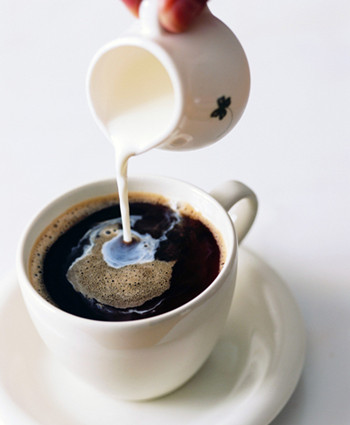Mocha pot brewing method Mocha pot brewing coffee common sense
The mocha pot is a way for Italians to make coffee and is suitable for the personal use of people with strong flavors. The concentration of brewed coffee is close to that of Espresso, but because the pressure it produces is not enough, it cannot be called Espresso in a strict sense. The pot is easy to brew, beautiful in shape and does not take up space, so it is a more economical choice for ordinary families. However, it must be noted that the grinding of coffee powder should be finer, and the cooking time and water quantity should be mastered.

In the early days, mocha pots were mostly made of aluminum, but now they are mostly made of stainless steel.
Prepare materials:
1, coffee powder, 8-9 grams (choose Espresso-specific coffee beans as much as possible, grind to the level of fine sugar. If ground too fine, the coffee powder will penetrate the metal filter, leaving residue, and cause excessive extraction and too bitter, too astringent, if grinding too coarse, hot water will pass through the coffee too quickly, resulting in insufficient flavor of extraction.)
2. The right amount of water (measured by the amount of water that boils a cup of Espresso, it is about 60-70 milliliters. Considering that the coffee powder absorbs water, about 70-80 ml of water is injected.
3. A set of mocha pots (about one or two cups of coffee)
4. Mocha special alcohol stove + bracket (JCL). (induction cookers and liquefied gas stoves can also be used. Mocha pots are generally small and cannot be stabilized on normal-sized gas stoves, so it is important to buy a stable bracket.)
5, 10 grams of coffee spoon
6. A set of Italian coffee cups and plates
Steps:
1. Pour the water into the mocha kettle (hot water is also available). Be careful that the water is not higher than the safety valve.
2. Put an appropriate amount of fine ground coffee powder into the middle coffee container and squeeze gently with the bottom and edge of the spoon to remove the gas from the coffee as far as possible and fill the gap on the edge of the small box. (it is best to fill the coffee container and flatten the coffee gently so that the water will stay in the coffee longer and the coffee will not be too thin.)
3. Gently insert the coffee particles left on the edge of the small box with your fingers, and then put the small box on top of the lower pot filled with water.
4. Tighten the upper and lower pots of the mocha pot, and pay attention to keeping the pots upright so as not to soak the coffee prematurely.
5. Heat the mocha pot over medium to low heat. And pour boiling water into the coffee cup and medium temperature cup.
6. When the water boils, the steam produced will cause the water to enter the coffee through the funnel. Turn down the fire immediately (if the fire is still very big, the water will quickly filter the coffee, making the coffee sour and thin); when there is a sound of water and bubbling in the pot, steam comes out and the aroma of the coffee wafts out, it means the coffee is ready.
7. Turn off the heat source, and after the bubbling stops, you can pour the pot of coffee into the cup and taste the authentic Italian coffee.
Note:
1. If you are afraid that the coffee brewed from the mocha pot has residue, you can buy a special round filter paper and put it between the coffee powder and the upper seat filter.
2. Do not leave the espresso pot on the stove with heat source.
Do not leave the mocha pot without water at the bottom on the stove for too long.
4. The mocha pot should be cleaned after each use.
5. Make sure that the sealing rubber at the bottom of the pot can still be used normally.
6. Before tidying up the coffee pot, make sure that the bottom of the lower part of the pot has been wiped dry and there are no water marks left.
Important Notice :
前街咖啡 FrontStreet Coffee has moved to new addredd:
FrontStreet Coffee Address: 315,Donghua East Road,GuangZhou
Tel:020 38364473
- Prev

The French style of the French kettle
Pressure filter is one of the most commonly used methods for French people to make coffee. It is said to have been invented by a French engineer. It can fully show the quality and characteristics of coffee beans. Mr. Mr.Kramer, founder of the European Special Coffee Association and the setter of professional standards for baristas of the European Special Coffee Association, mentioned when talking about the use of French filter pots to make coffee.
- Next

Common sense of how to make a good iced coffee
Remarks: 1. Cups: use glasses or other (choose cups according to your preferences). two。 Machine: tea maker, drip coffee machine (automatic coffee maker), commercial coffee equipment. 3. Thin sugar: cotton sugar is diluted into liquid after being diluted with hot water, so the sugar is thin. The practice of ordinary iced coffee: equipment: tea maker or drip coffee machine (automatic coffee maker), glass. Materials
Related
- Beginners will see the "Coffee pull flower" guide!
- What is the difference between ice blog purified milk and ordinary milk coffee?
- Why is the Philippines the largest producer of crops in Liberia?
- For coffee extraction, should the fine powder be retained?
- How does extracted espresso fill pressed powder? How much strength does it take to press the powder?
- How to make jasmine cold extract coffee? Is the jasmine + latte good?
- Will this little toy really make the coffee taste better? How does Lily Drip affect coffee extraction?
- Will the action of slapping the filter cup also affect coffee extraction?
- What's the difference between powder-to-water ratio and powder-to-liquid ratio?
- What is the Ethiopian local species? What does it have to do with Heirloom native species?

